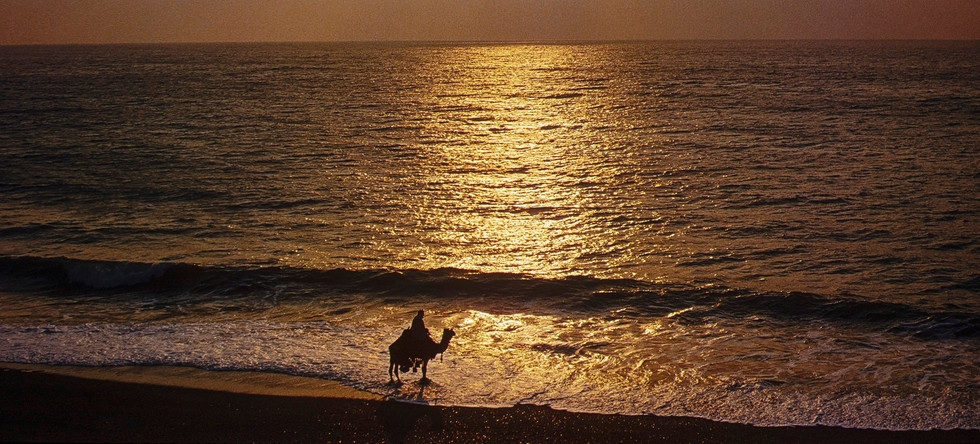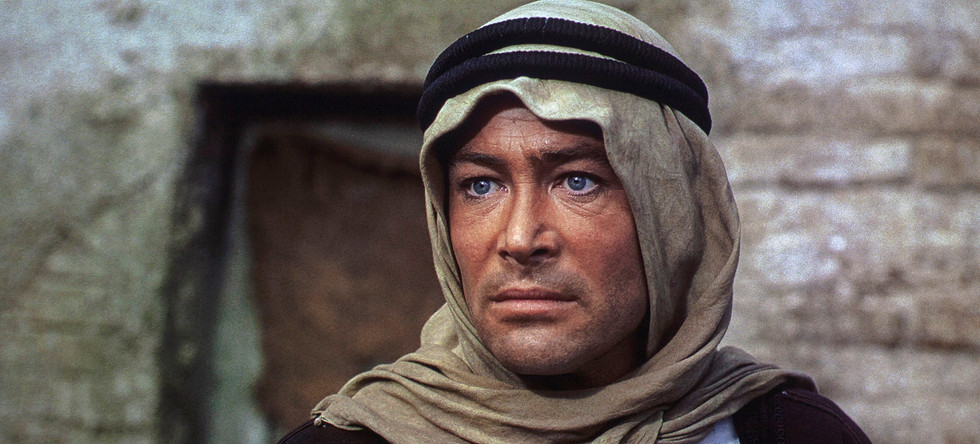“Lawrence of Arabia” sweeps onto new 4K Ultra HD
- Bill Kelley III
- Jun 18, 2020
- 7 min read
Updated: Jun 8, 2022
4K ULTRA HD REVIEW / HDR FRAME SHOTS

Peter O’Toole was nominated for an Academy Award as British officer T.E. Lawrence, who lead an Arab revolt against Turkey during World War I. Sherif Ali (Omar Sharif) tries to convince Lawrence to not attack the retreating Turkish army.
(Click an image to scroll the larger versions)
“LAWRENCE OF ARABIA”
4K Ultra HD, Blu-ray Digital copy; 1962; PG for war violence; streaming via Amazon Video Prime (4K), Apple (4K), FandangoNOW (4K), Google Play, Movies Anywhere (4K), Vudu (4K), YouTube
Best extra: A pop-up picture graphic track, with hundreds of factoids and photographs (Blu-ray version only)
THOSE WHO have never seen David Lean’s dazzling “Lawrence of Arabia” – it won seven Oscars – are in for a great 4K experience. At nearly four hours, it has the best picture (clarity and HDR toning) an Ultra HD format has to offer. Stanley Kubrick’s “2001 A Space Odyssey” is only a distant second.
The story, based on the extraordinary life of T.E. Lawrence, is treasured by moviegoers and filmmakers. The American Society of Cinematographers selected “Lawrence” as the greatest milestone in cinematography for the 20th Century. Ridley Scott’s “Blade Runner” (1982) came in at No. 2, and Francis Ford Coppola’s “Apocalypse Now” (1979) at No. 3.
Steven Spielberg was a bright-eyed 16-year-old when he first saw Peter O’Toole in the role. “I walked out of the theater stunned and speechless,” he recalls in one of nearly a dozen carry over extras found on the enclosed special features Blu-ray. “I didn’t understand the impact until months later,” he says. “It pulverized me.”
(WARNING: Some of the announced extras are missing on the bonus disc and Sony plans to restamp and forward to all purchasers. Right now, you can watch all of the extras on the iTunes version.)
(1) “Lawrence of Arabia” was filmed over two years with a $12 million budget, which received glowing press notices and played for a year in London, Madrid, and throughout the U.S. (2) Lawrence's fatal motorcycle accident. (3) Mr. Dryden (Claude Rains), a French civilian member of the Arab Bureau, selects Lt. Lawrence, to evaluate the Arab revolt against the Turkish military. (4) Lawrence begins his journey with guide Tafas (Zia Mohyeddin) to find the Hashemite Bedouins.
Based on “Seven Pillars of Wisdom,” Lawrence’s autobiographical account of leading an Arab revolt against Turkey during World War I, Lean’s epic inspired a generation of filmmakers to use the camera as a paintbrush. Young Spielberg was so captivated, he bought Maurice Jarre’s Oscar-winning soundtrack and played it over and over. The LP set included production photographs, which gave him a glimpse into Lean’s cinematic magic. Spielberg still considers “Lawrence of Arabia” the one film that’s had the biggest influence on his career.
The meticulous restoration orchestrated by Sony Pictures of “Lawrence of Arabia” makes the new Columbia Classics 4K Ultra HD Collection: Volume One – A MUST BUY.
The box set also includes five more iconic Columbia favorites: Frank Capra’s “Mr. Smith Goes to Washington” (1939), which received 11 Oscar nods; Stanley Kubrick’s dark comedy “Dr. Strangelove or How I Learned to Stop Worrying and Love the Bomb” (1964) nominated for four Oscars; Lord Richard Attenborough’s biopic “Gandhi” (1982), winner for Best Picture, Best Director and Best Actor for Ben Kingsley; Penny Marshall’s sports comedy “A League of Their Own” (1992), the oddball that didn’t receive a single Academy Award nod, but became a crowd darling last year when Sony solicited possible picks for the 4K box set; and Cameron Crowe’s redemptive RomCom “Jerry Maguire” (1996), which received five Oscar nods.
“The real spectacle of the screen is something people aren’t used to – they don’t see it anymore. ‘Lawrence’ has a lot to do with my first thrills in seeing my first silent pictures. It’s all about telling a story in pictures.” — David Lean, Variety Magazine in 1989
(1&2) Lawrence and Tafas stop at a watering well, which leads to the death of the guide by Sherif Ali the owner of the well. (3&4) Lawrence, Sherif Ali, and members of Prince Feisal band of rebels cross the Nefud Desert to make an assault on Aqaba, a Turkish port on the Red Sea.
VIDEO
The original, larger format 65mm negative (2.20:1 aspect ratio) of “Lawrence” from Lean and Oscar-winning cinematographer Freddie Young was scanned at 8K almost a decade ago, then downsized to 4K to process the digital workflow. The negative had plenty of issues; it was plagued with color fading, chemical stains, and normal wear and tear. To handle the enormous project, Sony split the workload between two digital labs – one in India and the other in Burbank, Calif. A year later, “Lawrence” was reassembled and samples were circulated to make sure the restoration looked just right.
The 4K master from 2012 was the basis for creating the new HDR version (HDR10 and Dolby Vision). Because of the added resolution extracted from the HDR toning, Sony was forced to do another round of restoration to fix minor and major flaws as noted in the 12-pages highlighting “Lawrence” within the 80-page coffee table book for the Columbia Classics box set. Contrast levels are unlike any seen before, giving authenticity to all shades of black, brown and everything in-between for the diverse cast including Egyptian Omar Sharif as Sherif Ali, Latino actor Anthony Quinn as Auda Abu Tayi, and Englishman Alec Guinness made up as Prince Faisal. Highlights are just as striking and controlled with intense rays of sunshine and endless sea of sand. The desert scenes were filmed in Jordan for 117 days.
Natural film grain is ever-present, even though it’s sourced from the larger negative. A wide shot photographed from a distant hillside has perfect clarity showing hundreds of bedouins on horse and camel from two united Arab tribes under Lawrence’s heroic leadership, taking Aqaba from the Turkish military.
To ensure the best picture possible, "Lawrence" is spread across two 4K discs, with a perfect break at the Intermission – the two hour and twenty-minute mark.
AUDIO
Originally, Sony hadn’t planned a new Dolby Atmos soundtrack sourced from the six-track stereo composite mix made during the last analog restoration in 1988. But, the studio used its own A.I. Sound Separation software to split out some of the components to provide a more encompassing and immersive soundstage. From the prologue’s opening that runs over four minutes with Jarre’s sweeping score and a black screen, some of the orchestration is pushed to height speakers. My only complaint is the bass response is too heavy, with timpani concert drums. It will cause vibrations for walls and furniture. It even caused my projector to vibrate from its ceiling mount. The gunshot effects are extremely effective bouncing around the room.
(1) Sherif Ali and his men are unsure of the arrival of Sheik Auda Abu Tayi (Anthony Quinn) and his tribe. (2) Lawrence convinces Auda Abu Tayi to join the mission to take Aqaba from the Turks. (3) A cast of thousands is involved in the attack scene, as Lean's wide shots are sweeping and majestic. (4) After conquering Aqaba Lawrence watches the sunset on the Red Sea.
EXTRAS
Spielberg also remembers how Lean provided a personal “DVD commentary” after its first restoration, which Spielberg and Martin Scorsese helped finance. Lean was seated between the two directors. “He hadn’t seen it in years, and was giving all this backstage insight,” says Spielberg, who renews himself by watching “Lawrence” before every new project.
Scorsese remembers his first encounter with “Lawrence,” during the featurette “The Lure of the Desert.” He saw it with his buddies during a reserved seating engagement in 70mm in New York City. “It was one of the most extraordinary events in cinema.” He also finds Lawrence is like a character you might find in a film noir, like “Detour” by Edgar G. Ulmer, “where the character is tripped up by his own fate. You can’t figure him out, and why should you? He’s presented that way.”
Initially, Marlon Brando and Albert Finney were first considered for the role, but they turned it down. O’Toole reveals how he got the part that turned him into an “overnight sensation” during a featurette from 2012. He was playing in Shakespeare’s “The Merchant of Venice,” when he got a phone call from Lean to come to London. Hundreds had already auditioned, but Lean’s wife at the time, originally from India, traveled with a guru. The guru had seen O’Toole playing a young Army officer in a small black-and-white film, “The Day They Robbed the Bank of England.” He announced to Lean, “I’ve just seen the man who must play in “Lawrence of Arabia.”
In the 60-minute ‘Making of’ documentary, Lean says during a 1989 interview he was drawn to Lawrence’s WWI journey because “It’s one whale of an epic. Not far off a sort of movie opera.” The mystique of T.E. Lawrence hit its peak during the late 1930s and ‘40s after his death, says film historian Adrian Turner. “He created a myth about himself by dying young.”
(1-3) Lawrence returns to British headquarters in Cario with Farraj (Michel Ray), a teenager who's given his allegiance to Lawrence.
Lawrence’s death is shown during the opening title sequence. At the time, conspiracy theories took center stage. “He just couldn’t die in a motorcycle accident,” Turner says. “Lawrence was a complicated man who craved privacy, anonymity, and yet loved to be famous.”
Right after WWI, American newscaster Lowell Thomas was the driving force behind Lawrence’s popularity, lecturing and showing footage of the Englishman’s Arabian adventures to packed houses in London and New York, which eventually gained interest from Hollywood Studios. In the film, character Jackson Bentley (Arthur Kennedy) plays the American journalist.
For various reasons, no film was made until Lean became involved. His curiosity about the epic also started in the 1930s, with his associate Norman Spencer, although the head of London Films had reservations. The movie wasn’t guaranteed until the release of World War II classic and Best Picture winner, “The Bridge of the River Kwai,” became a hit for Lean and U.S. producer Sam Spiegel.
Before Lean could start on his adaptation, he met with T.E’s brother, Professor Arnold Lawrence, who controlled the copyrights and access to materials. Initially, Prof. Lawrence wasn’t interested, but approved once he had total script approval. Michael Wilson, a blacklisted, uncredited writer on “Kwai,” worked on “Lawrence of Arabia” for two years creating a massive first draft. Lean’s reaction wasn’t good, so he hired British playwright Robert Bolt of “A Man for All Seasons.” Bolt wrote the script on Spiegel’s yacht in Jordan’s Gulf of Aqaba.
“When it comes to working with “Lawrence of Arabia” film elements, nothing comes easily.” Mr. Crisp went into this project forewarned – eyes fully open. And he has come out the other side, using every bit of digital technology available, for a final product that would please Sir David Lean.” — Robert A. Harris, restoration expect
— Bill Kelley III, High-Def Watch producer
Disc Two
(1) American journalist Jackson Bentley (Arthur Kennedy), asks Prince Faisal where he can find Major Lawrence? (2&4) Lawrence and Prince Faisal's army are blowing up Turkish trains.
(1-3) During one of the guerrilla raids on a Turkish train, Lawrence is hit by a grazing bullet.
(1-3) Lawrence is captured in Deraa and tortured by Turkish General Hajim Bey (José Ferrer) and his men. (4) Sherif Ali waits for his release. (4) Lawrence returns to Cario and British General Allenby persuades him to lead the attack on Damascus.


























































Comments